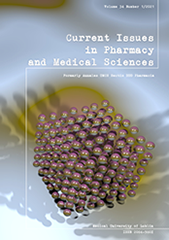Fatty acid composition of night-scented stock (Matthiola bicornis (Sibth. & Sm.) DC.) raw materials
DOI:
https://doi.org/10.2478/cipms-2021-0007Keywords:
fatty acids, gas chromatographyAbstract
Introduction. With due consideration of the properties of fatty acids, as well as their importance for normal life activity and human development, research into the fatty acid composition of poorly studied plants and the search for new domestic plant sources of polyunsaturated fatty acids is a mainstream trend in modern pharmacy.
Aim. Aim of research – determination of fatty acid qualitative composition and content in threshed grass, stalks, roots and seeds of Night-scented stock ‘Queen of Night’ and ‘Evening Scent’ cultivars as grown in Ukraine.
Methods. Gas chromatography.
Results. Both cultivars of Night-scented stock taken for analysis had similar fatty acid composition – 5 saturated, 5 (4 for seeds) monounsaturated and 2 polyunsaturated fatty acids, Quantitatively, in all tested parts of the herb polyunsaturated and monounsaturated fatty acid dominated, making in total 88.92% and 88.62% in the seeds of Queen of Night and Evening Scent cultivars, respectively, and averaging 65% in other parts of the tested cultivars. Linolenic and linoleic acids prevailed among the polyunsaturated fatty acids, whereas oleic acid prevailed among the monounsaturated.
Conclusion. Night-scented stock can be utilized as a source of polyunsaturated fatty acids for the development of drugs and for standardization of tested raw materials.
References
1. Glick NR, Fischer MN. The role of essential fatty acids in human health. J Evid-Based Complementary Altern Med. 2013;18(4):268-89.
2. Makarova SG, Vishneva EA. Long-chain polyunsaturated ω-3 and ω-6 fatty acids as essential nutrients in different periods of childhood. Pediatricheskaya farmakologiya (Pediatric pharmacology). 2013;10(4):80-8.
3. Ristić-Medić D, Vučić V, Takić M, Karadžić I, Glibetić M. Polyunsaturated fatty acids in health and disease. J Serb Chem Soc. 2013;78(9):1269-89.
4. Sokoła-Wysoczańska E, Wysoczański T, Wagner J, Czyż K, Bodkowski R, Lochyński S, Patkowska-Sokoła B. Polyunsaturated fatty acids and their potential therapeutic role in cardiovascular system disorders – a review. Nutrients. 2018;10(10):1561-82.
5. Davidyan OV, Vorslov LO. Omega-3 polyunsaturated fatty acids as a source of longevity. Vopr dietol (Nutrition). 2017;7(1):36-41.
6. Chekman IS, Gorchakova NA, Rudenko AV, Kurik MV, Orlov AA, Zagorodny MI, Osinnia LM. Clinico-pharmacological properties of polyunsaturated fatty acids (review of literature and own data). Zhurn NAMN Ukrayiny. 2013;19(3):286-96.
7. Rozhdestvenskij DA, Bokij VA. Clinical pharmacology of omega-3 polyunsaturated fatty acids. Mezhdunarodnye obzory: klinicheskaja praktika i zdorov’e. 2014;3(9):121-34.
8. Shysh AM, Frantsuzova SB, Nagibin VS, Moibenko AA. Mechanisms of cardioprotective effect of omega-3 polyunsaturated fatty acids in acute damage of myocardium under immobilization stress. Farmakologіya ta lіkars’ka toksikologіya. 2013;2(33):76-83.
9. Fabian CJ, Kimler BF, Hursting SD. Omega-3 fatty acids for breast cancer prevention and survivorship. Breast Cancer Research. 2015;17(1):62-73.
10. Ketsa OV, Marchenko MM, Shmarakov IO. Effect of ω-3 polyunsaturated fatty acids on the functional activity of monooxygenase system in the liver microsomal fraction of tumor-bearing rats. Fiziologichnyi Zhurnal. 2018;64(2):19-25.
11. Azimova SS, Glushenkova AI, Vinogradova VI. (eds) Lipids, lipophilic components and essential oils from plant sources. Springer; 2012:992.
12. Karaman S, Gulseven M, Comlekcioglu N, Ilcim A. Fatty acid composition of Matthiola longipetala ssp. bicornis from Turkey. Int J Agric Biol. 2011;13(4):581-5.
13. Lim TK. (ed). Edible medicinal and non-medicinal plants. Vol. 7: Flowers. Springer;2014:1115.
14. Yaniv Z, Schafferman D, Zur M, Shamir I. Evaluation of Matthiola incana as a source of omega-3-linolenic acid. Ind Crops Prod. 1997;6:285-9.
15. Fedosov AI, Kyslychenko VS, Novosel OM. Determination of fatty acid composition of garlic leaves and bulbs. Med Clin Chem. 2019;19(4):5-9.
16. Kyslychenko ОA, Protska VV, Zhuravel IО. The studies of fatty acids of the thalloms of Parmelia perlata. Fitoterapiya. Сhasopys. 2017;4:40-3.
Downloads
Published
Issue
Section
License
Copyright (c) 2021 Authors

This work is licensed under a Creative Commons Attribution-NonCommercial-NoDerivatives 3.0 Unported License.


